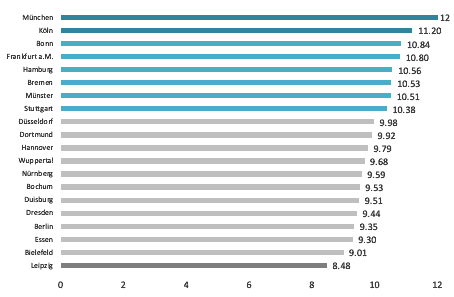In Germany, the introduction of the statutory minimum wage in January 2015 was viewed extremely sceptically by many economists. The majority of the German Council of Economic Experts wrote in the council’s annual report for 2013-14 (§486): ‘A nationwide minimum wage of 8.50 euros, as currently being considered for Germany, would affect a significant number of employees in this country and thus entail a comparatively high risk of job losses.’
The subsequent development of the German labour market has been analysed in a wealth of studies and numerous review articles. These all show that the minimum wage has increased incomes in the low-wage sector without any negative employment effects.
Despite this positive assessment, it must be asked whether the minimum wage has also achieved the goals intended for the instrument. The greatest challenge, looking at the wider picture, results from the fact that the cost of living—bearing down most heavily on those on low incomes—varies considerably within a country.
A study by Herzog-Stein et al (2018) concludes that, especially in many large cities in view of rapidly rising housing costs, the minimum wage often falls below subsistence level. ‘According to calculations by the WSI [Economics and Social Sciences Institute], the necessary hourly wage for full-time employees with an average collectively agreed working week of 37.7 hours in 19 of the 20 largest cities in Germany is currently well above the currently applicable minimum wage of EUR 8.84 ….’ (Figure 1).
Figure 1: Hourly living wage for a full-time single household in 2017 (euro)

This raises the question as to whether it might not make sense to supplement the national minimum wage via higher, regionally-differentiated minima. These can be found in Canada, the United States and Japan:
- Japan currently has a national minimum wage of 901 yen per hour; this however only serves as a guideline for the minimum wages set at the regional level.
- In Canada, minimum wages are set exclusively at the provincial level.
- In the US, there is a three-tier system, with a national minimum wage, minimum wages at the state level and, and in a number of states, additional minima at the municipal level.
As Figure 2 illustrates, the range is very wide in the US, while in Japan and Canada the highest minimum wage is around 30 per cent higher than the lowest.
Figure 2: Multi-level minimum-wage systems
| Lowest minimum wage | Valid for | Highest minimum wage | Valid for | |
| USA (USD) | 7.25 | US as a whole | 16.3 | Emery, CA |
| Canada (CAD) | 11.32 | Saskatchewan | 15 | Alberta |
| Japan (JPY) | 751 | Kagoshima | 985 | Tokyo |
From a microeconomic perspective, regionally-differentiated minimum wages can be regarded as a form of price discrimination. From elementary microeconomic theory, it is well known that price discrimination is always advantageous for a supplier, compared with a uniform price. Price discrimination enables the supplier to appropriate a part of the consumer surplus.
Regionally-differentiated minimum wages could therefore be used to improve the situation of employees in a more targeted manner than a uniform minimum wage. This was already recognised in the United States in the 1960s. Even today, the explanatory statement with which New York City Council passed a local minimum-wage law in 1962 is worth reading:
[S]ome persons employed in certain occupations are paid wages, which, in relation to the cost of living in the city and the income necessary to sustain minimum standards of decent living conditions are insufficient to provide adequate maintenance for themselves and their families; that the employment of such persons at such wages impairs the health, efficiency and well-being of the persons so employed and of their families, constitutes unfair competition with other employers and their employees … Employment of persons at such insufficient rates of pay threatens the health, welfare and well-being of the people of the city and injures the city’s economy.
There are not many studies that have dealt with the effects of local minimum wages. John Schmitt and David Rosnick (2011) show for Santa Fe and San Francisco that a citywide minimum wage can raise the earnings of low-wage workers, without a discernible impact on their employment. Manzo et al (2018) come to a similarly positive conclusion for Chicago. The minimum wage in Seattle is assessed differently. While Reich et al (2017) do not see negative effects on employment in the food industry, Jardim et al (2018) state ‘that the less experienced half saw larger proportionate decreases in hours worked, which we estimate to have fully offset their gain in wages, leaving no significant change in earnings’.
Overall, the growing popularity of this instrument, particularly in California, indicates that, from the perspective of local authorities, positive effects are expected on balance. While there were only five local minimum wages in the US before 2012, there are now 50 at city or county level.
Given the negative effects of the coronavirus crisis on labour markets, which will probably persist for a few more years, it will be difficult to push through significant increases in national minimum wages. In this difficult situation, local minimum wages offer the opportunity to improve the financial situation of workers in large cities, in a flexible and targeted manner. In any case, Europe should examine seriously the largely positive experience of this approach in the US.
This article is a joint publication by Social Europe and IPS-Journal
Peter Bofinger is professor of economics at Würzburg University and a former member of the German Council of Economic Experts.

